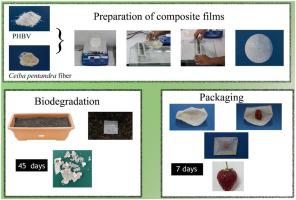当前位置:
X-MOL 学术
›
Food Packag. Shelf Life
›
论文详情
Our official English website, www.x-mol.net, welcomes your
feedback! (Note: you will need to create a separate account there.)
Novel biodegradable polymer films based on poly(3-hydroxybutyrate-co-3-hydroxyvalerate) and Ceiba pentandra natural fibers for packaging applications
Food Packaging and Shelf Life ( IF 8.5 ) Pub Date : 2020-09-01 , DOI: 10.1016/j.fpsl.2020.100538 Sandhya Alice Varghese , Harikrishnan Pulikkalparambil , Sanjay Mavinkere Rangappa , Suchart Siengchin , Jyotishkumar Parameswaranpillai
Food Packaging and Shelf Life ( IF 8.5 ) Pub Date : 2020-09-01 , DOI: 10.1016/j.fpsl.2020.100538 Sandhya Alice Varghese , Harikrishnan Pulikkalparambil , Sanjay Mavinkere Rangappa , Suchart Siengchin , Jyotishkumar Parameswaranpillai

|
Abstract In this work novel poly(3-hydroxybutyrate-co-3-hydroxyvalerate) (PHBV) polymer composites were prepared by incorporating Ceiba pentandra bark fibers. The casting technique was used for the preparation of the composites. The effect of Ceiba pentandra bark fibers on the morphology, thermo-mechanical, hydrophilicity, transparency, biodegradability, antimicrobial, and packaging properties were studied. The scanning electron microscope was used for morphological characterization while Fourier transform infrared spectroscopy was used for structural analysis. The investigation was done on the mechanical properties, percentage crystallinity, and biodegradability of these composites. It was found that the incorporation of fibers enhanced the tensile properties, percentage crystallinity, and the biodegradability of the composite when compared to that of the virgin PHBV. Additionally, all the biocomposites show good thermal stability. Antimicrobial studies showed that the composite films of higher fiber loading showed antibacterial activity against S.aureus while no activity was shown against E. coli. Finally, these composite films were used for packaging of fresh strawberries which showed that the strawberries packed in films of fiber loading above 10 % have better preservation of freshness of the fruit than unpacked strawberries which showed mold attack after 7 days of packing.
中文翻译:

用于包装应用的基于聚(3-羟基丁酸酯-co-3-羟基戊酸酯)和 Ceiba pentandra 天然纤维的新型可生物降解聚合物薄膜
摘要 在这项工作中,通过加入木棉树皮纤维制备了新型聚(3-羟基丁酸酯-co-3-羟基戊酸酯)(PHBV)聚合物复合材料。铸造技术用于制备复合材料。研究了木棉树皮纤维对形态、热机械、亲水性、透明度、生物降解性、抗菌性和包装性能的影响。扫描电子显微镜用于形态表征,而傅里叶变换红外光谱用于结构分析。对这些复合材料的机械性能、结晶度百分比和生物降解性进行了研究。发现纤维的掺入提高了拉伸性能、结晶度百分比、与原始 PHBV 相比,复合材料的生物降解性。此外,所有生物复合材料都显示出良好的热稳定性。抗菌研究表明,纤维含量较高的复合膜对金黄色葡萄球菌具有抗菌活性,而对大肠杆菌则没有活性。最后,将这些复合薄膜用于新鲜草莓的包装,结果表明,与未包装的未包装草莓相比,包装在纤维含量高于 10% 的薄膜中的草莓更能保持水果的新鲜度,未包装的草莓在包装 7 天后出现霉菌。
更新日期:2020-09-01
中文翻译:

用于包装应用的基于聚(3-羟基丁酸酯-co-3-羟基戊酸酯)和 Ceiba pentandra 天然纤维的新型可生物降解聚合物薄膜
摘要 在这项工作中,通过加入木棉树皮纤维制备了新型聚(3-羟基丁酸酯-co-3-羟基戊酸酯)(PHBV)聚合物复合材料。铸造技术用于制备复合材料。研究了木棉树皮纤维对形态、热机械、亲水性、透明度、生物降解性、抗菌性和包装性能的影响。扫描电子显微镜用于形态表征,而傅里叶变换红外光谱用于结构分析。对这些复合材料的机械性能、结晶度百分比和生物降解性进行了研究。发现纤维的掺入提高了拉伸性能、结晶度百分比、与原始 PHBV 相比,复合材料的生物降解性。此外,所有生物复合材料都显示出良好的热稳定性。抗菌研究表明,纤维含量较高的复合膜对金黄色葡萄球菌具有抗菌活性,而对大肠杆菌则没有活性。最后,将这些复合薄膜用于新鲜草莓的包装,结果表明,与未包装的未包装草莓相比,包装在纤维含量高于 10% 的薄膜中的草莓更能保持水果的新鲜度,未包装的草莓在包装 7 天后出现霉菌。











































 京公网安备 11010802027423号
京公网安备 11010802027423号